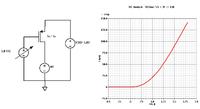AMSA84
Advanced Member level 2

- Joined
- Aug 24, 2010
- Messages
- 577
- Helped
- 8
- Reputation
- 16
- Reaction score
- 8
- Trophy points
- 1,298
- Location
- Iberian Peninsula
- Activity points
- 6,178
Has the title says, I am not being sucessful on plotting the I-V characteristic of a PMOS transistor, using cadence.
Can someone give me a tip on how to do it?
Kind regards.
Can someone give me a tip on how to do it?
Kind regards.

